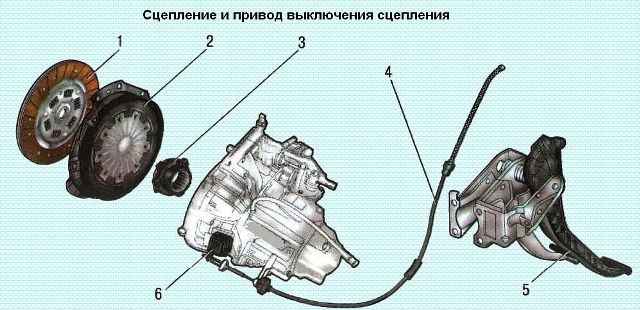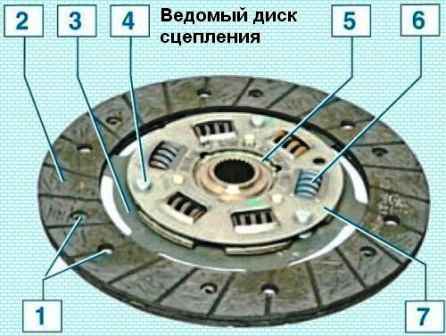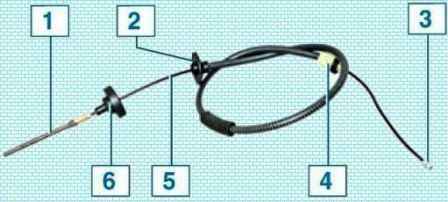Clutch with manual transmission - dry, single plate, diaphragm.
The clutch mechanism is located in the crankcase, combined with the gearbox.

The clutches of engines with a working volume of 1.4 and 1.6 liters are the same in design and differ only in the diameter of the driven and pressure plates.
For a 1.4 liter engine, the diameter is 180 mm, for a 1.6 liter engine it is 200 mm.
The values of the stroke of the outer arm of the clutch release fork are also different.
For a 1.4L engine, the stroke is 28-33mm, for 1.6L engines it is 30-35mm.

The clutch basket is connected with six bolts to the engine flywheel. Three pins are pressed into the flywheel to center the basket.
The clutch housing contains a diaphragm spring made of spring steel.
The diaphragm spring consists of eighteen petals, which are elastic release levers.
Due to the elasticity of the levers, the diaphragm spring creates a uniform pressure on the clutch pressure plate and contributes to smooth engagement and disengagement of the clutch.
The need to replace the basket occurs when the diaphragm spring petals are worn to a depth of more than 0.8 mm, as well as in the event of a decrease in pedal force when the clutch is disengaged, which indicates a large wear of the pressure plate surface or a diaphragm spring settlement.

The driven disk with a spring vibration damper is mounted on the splines of the input shaft of the gearbox between the flywheel and the pressure plate.
The damper provides an elastic connection between the clutch disc and the input shaft of the gearbox, and also dampens torsional vibrations arising from dynamic loads in the transmission and uneven engine operation, two friction linings of the disc are riveted on both sides to the spring plate, which, in turn, turn, riveted to one of the two damper plates.
A disk hub is installed between the damper plates.
Damper springs are installed in the holes of the hub and damper plates.
The damper plates are connected by three support pins.
In the disc hub, opposite the support pins, there are cutouts that allow the hub to rotate within certain limits relative to the damper plates, while compressing the damper springs.
This allows you to reduce dynamic loads in the transmission when starting the car and when shifting gears.
The driven disk is replaced if its axial runout in the area of the friction linings is more than 0.5 mm, oiling, cracking, scuffing or uneven wear of the linings, weakening of the rivet joints, and also if the heads of the rivets are deepened from the surface of the linings by less than 0.2 mm.

Clutch drive on cars - cable, backlash-free.
The front end of the cable is attached to the clutch release fork, and the rear end is attached to the clutch pedal holder.
The front tip is threaded, used to adjust the clutch release drive.
The clutch pedal is mounted on an axle in the pedal assembly bracket. A pedal return spring is installed on the same axle.
The fork pivots on a ball joint installed in the clutch housing.
A clutch release bearing is installed between the clutch release fork and the diaphragm spring petals.
On the sleeve The ipnik has two hooks with which it hooks onto the legs of the fork.
A clutch drive scheme has been applied, in which the bearing is constantly pressed against the petals of the diaphragm spring.
The bearing moves freely along the guide sleeve pressed into the clutch housing.
Clutch disengagement is as follows.
When the clutch pedal is depressed, the cable turns the clutch release fork, which moves the bearing along the guide sleeve.
The bearing presses on the petals of the diaphragm spring.
The spring, deforming, stops pressing the pressure plate against the flywheel, while the pressure plate moves away from the flywheel, as a result of which the engine crankshaft and the gearbox input shaft can rotate independently of each other.
When the clutch pedal is released, the bearing returns to its original position, while the diaphragm spring again begins to press on the pressure plate, which, in turn, presses the driven disc against the flywheel - as a result, the transmission of torque resumes.
Possible clutch failures and solutions
Causes of malfunction - Methods of elimination
Jerks when starting off:
Clutch cable sticking - Apply engine oil to the cable. If the cable is damaged, replace it
Jamming of the driven disk hub on the splines of the input shaft of the gearbox - Clean the splines from dirt, eliminate minor damage with a file.
In case of significant wear or damage to the splines, replace the disc or the input shaft of the gearbox.
Before assembly, apply SHRUS-4 grease to the splines.
Distortion of the driven disc - Replace the driven disc
Weakening of the friction linings of the driven disc, severe wear or cracks on the lining - Replace the driven disc
Loss of elasticity of driven disc spring plates - Replace driven disc
Significant settlement or breakage of the springs of the damper of torsional vibrations, wear of the windows under the springs - Replace the driven disk
Scoring on the running surfaces of the flywheel or pressure plate - Replace the flywheel or clutch housing with pressure plate assembly (clutch basket)
Oiling the working surfaces of the friction linings of the driven disk - Thoroughly wash the oiled surfaces with white spirit or gasoline and wipe them dry. Replace heavily oiled driven disc. Eliminate the cause of oiling.
Rattle, knock or noise when engaging the clutch:
Significant settlement or breakage of the springs of the damper of torsional vibrations, wear of the windows under the springs - Replace the driven disk
Distortion of the driven disc - Replace the driven disc
Weakening of the friction linings of the driven disc, severe wear or cracks on the lining - Replace the driven disc
Increased noise when disengaging the clutch:
Worn, damaged or leaking lubricant from clutch release bearing - Replace bearing
Clutch slips (not fully engaged) when the gas pedal is pressed hard, the engine picks up speed, but the car does not accelerate
Oiling the flywheel, pressure plate and friction linings of the clutch disc - Wash the oiled surfaces with gasoline and wipe them dry. Replace heavily oiled disc. Eliminate the cause of oiling.
Decreased diaphragm spring force - Replace drive disc (basket)
Severe wear or burnt friction linings of the driven disc - Replace the driven disc
Clutch actuator damage or binding - Eliminate binding. Replace drive parts if necessary.
Clutch leads (not fully disengaged)
Clutch engages (does not disengage completely) forward shifting is difficult, reverse gear shifts noisily with a good gearbox:
Incorrect adjustment of the clutch drive (insufficient full pedal travel) - Adjust the drive
Clutch cable sticking - Apply engine oil to the cable. If the cable is damaged, replace it.
Loose rivets or breakage of friction linings, warping of the driven disk (end runout more than 0.5 mm) - Replace the driven disk
Heavy and uneven wear, scuffing on the working surfaces of the flywheel or clutch pressure plate - Replace the flywheel. If the surface of the pressure plate is damaged, replace the casing with the pressure plate assembly (clutch basket)
Distorted or warped pressure plate - Replace cover with pressure plate assembly (clutch basket)
Seizure of the driven disk hub on the splines of the input shaft of the gearbox - Clean the splines from dirt, eliminate minor damage with a file. In case of significant wear or damage to the splines, replace the driven disk or the gearbox input shaft.




